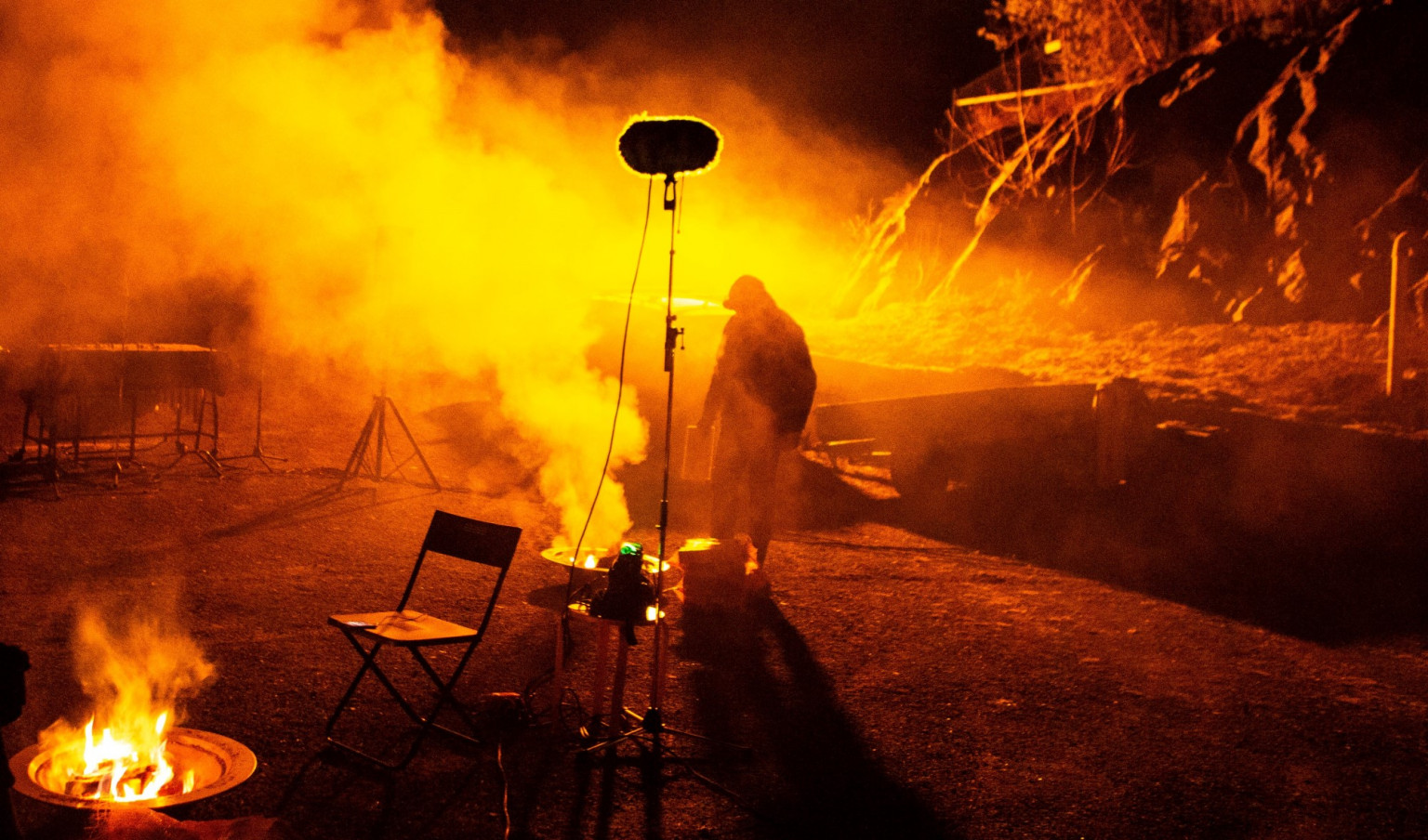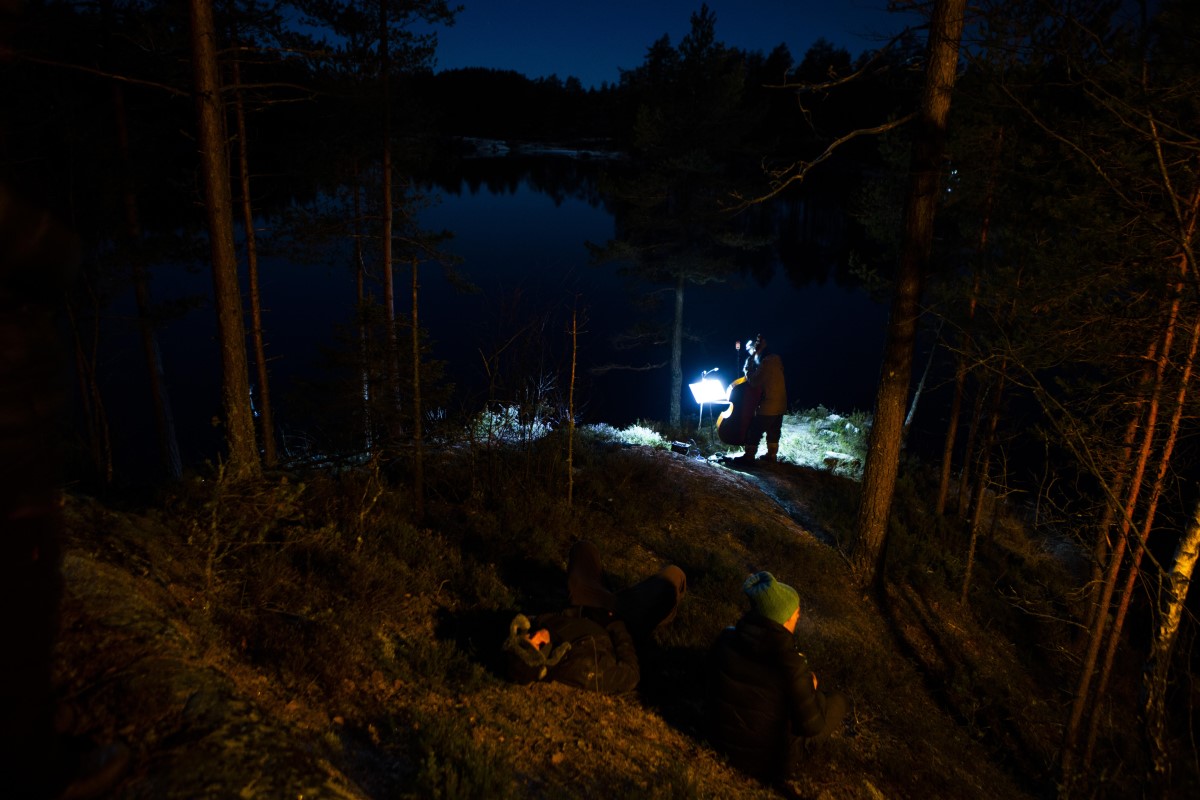
Deep in the Norwegian forest
Towards the end of October I received an invitation to the following in my inbox:
‘Himdalen – outdoor concert’
Himdalen, Akershus in Norway
Time: 18:00 to 07:00 the next morning
The entire evening and night outdoor in the dead of November
A site-specific concert by Knut Olaf Sunde
Knowing his previous work Comfort Music (2015), a 90-minute concert performance in which the audience is divided into two groups – one sitting quite conventionally in a concert venue, the other taken to a nearby bunker with a live-stream from the hall – the Norwegian composer Knut Olaf Sunde’s approach to writing music is distinctive.
Directed, misdirected, subtly re-directed, we the audience submit to Sunde’s will
In particular his approach to negotiating an audience, confronting ideas of what a piece of music is. Subtly and over time changing through a piece the terrain of what we think is going on. Nothing overt shifts, nothing startling. Directed, misdirected, subtly re-directed, we the audience submit to Sunde’s will. His grip of us the audience, over time, confounds us. Confounds where we thought we were and where we find ourselves at the end of a piece of his.
Knut Olaf Sunde has a unique way of constructing musical material, compatible with his ideas about handling an audience in these new ways. Elements of external narrative drama placed in his works, the spice of the unknown, confront an audience with what they expect when hearing music.
In the dead of November
From the phrasing of the invite this new work seemed awesomely extreme. I was drawn instantly to the phrase in the dead of November. Knowing Norwegian winter weather, the challenge of a durational piece through the dead of a Norwegian night was strangely enticing. How would we the audience handle a work lasting through the night? What challenges would be thrown up for the players and for the sound system? The spectre of a Blair Witch Project (1999) element held me in its thrall also. With Knut Olaf Sunde it was impossible to predict what would take place. I accepted the invitation.
Further background and instructions arrived:
Himdalen is a small unpopulated valley surrounded by pine forest hills an hour by car east of Oslo. The only storage and repository facility for radioactive waste in Norway is located here. The site and its function of storing waste of long half-life arises questions about communication, especially across extreme time spans. Radioactive substances have half-times from seconds via decades to billions of years. The greater the time span, the more difficult the understanding of context becomes. Myths were the realistic channel of saving information prior to scripture evolved more than five thousand years ago. And myths have been interpreted in what was always the present context. Meaning does not merely arise as information is conveyed, but is dependent upon context, of how we perceive situations, cultures, civilizations, the world and our immediate surroundings.
Physical presence and manoeuvring in the local landscape are necessary to try and put the outspread elements of the work together. The audience must navigate the area, in darkness, with uncertainty, inconvenience and strain. The sound situations are prolonged, almost stagnant processes.
Protest through composition
Part of Comfort Music took place in Nødsentralen, a defunct emergency communications centre, in the Torshov district of Oslo, a nuclear bunker built for the safety of the government during the Cuban missile crisis. Both works thereby conforming to anti-conventional concert venues, underlining a political message which colours Sunde’s works.
Norway has recent pedigree in protest through composition – as in Maja Ratkje’s Desibel (2010), an anti-mining piece written for 10-metre loudspeaker horns placed above Sunnfjord – so this was not unfamiliar territory. Eloquent was Sunde’s notional pairing of a long work to the longevity of radioactive substances. Using the length of a durational piece to express the artistic – and political – idea of how long exactly the life span radioactive substances endure. Time dissolving into grains of sand, ephemeral.
Challenging an audience’s traditional expectations of what takes place in the concert hall is Sunde’s most unique marker
Challenging an audience’s traditional expectations of what takes place in the concert hall is Sunde’s most unique marker. It is this thread which, as a perceiver of contemporary music, is the most exciting, throwing me back to summer 1990 when I encountered Catalan theatre troupe La Fura dels Baus who challenge expectations of the theatre audience with practices similar to Sunde’s approach in music. Renegotiating the terms of what a performance is; new ways in which the audience engage with their time involved in a piece of performance. In Comfort Music a spell woven over his audience, already confounding expectations of music in a concert hall setting.
This is so very relevant to Knut Olaf Sunde’s work in bending, moulding, shaping and designing what takes place in the concert hall. Added in now were specificities of outdoor location, duration. Here we are to leave the concert hall for a sub-zero camping trip in the Norwegian forest. Compelling.
To see how this unfolded, where else would I rather be on this particular Saturday night?
Into the woods
With nightfall, the moment arrived. Oslo was already cold. Meeting fellow participants, ironically outside Hotel Opera, we knew we were embarking on a distinctive experience together, a kinship forming as the bus took us (Aksiom ensemble players and audience) to Himdalen. Enjoying the warmth while it lasted, I snoozed until at a given moment over the intercom abrasive and jarring musical material signalled the beginning of our night’s journey. It had begun.
It is hard to put into words all that took place that night
It is hard to put into words all that took place that night. It became very cold quite quickly, the Norwegian weather service reporting -14 degrees. Site-specific (forest, valley, steep hills to gambol over to reach a lake and a wonderful home for the night of a base camp with two ever-burning fires), this was a camping trip like no other.
On arrival we were given a map stating locations of various performances through the night. The Aksiom ensemble – this night consisting of double bass, guitar, percussion and harmonium – was throughout supported by electronics. For participants it was as if we were on a quite particular field trip, but happily given the bonus instruction to just do what we felt like, there were no rules. Those providing the music for the event were however on a strict schedule governed by precision timings and instructions in effecting their part that contributed to the whole.
There was an accompanying sonic environment to our every moment in the valley, in a wide variety of forms, from pulsating to drone to rhythmically percussive materials. Notable early in the night was a mathematically quantised electronic pulse expanding over time with acute precision, instantly provoking in me a kinaesthetic anticipatory, predictive response – and I hadn’t realized I was paying attention. I giggled at the perfection in its quantised pattern, still sitting casually round the fire. The two situations seemed perfectly matched and fun, if slightly off beam with the dark Norwegian night.
The lake session
The electronic presence served as a low-fi backdrop to normal camp activities, burger cooking, eating, Tuborg drinking, warming and just chatting round the fire. A quiet yet elegiac party was beginning. The valley, host to sonic experimentation of sound echoing out of site-specifically placed speakers pulsing across the tranquil acoustic of the valley. As we wandered to each new event conversations sparked up about whale song, recording whales (in Hawaii), other such natural sonic curiosa. There was a gentle ritual to the whole event over time.
We had reached a different place. A place profoundly elemental
The ensemble punctuated the electronic backdrop after a few hours. First, sustained and elongated durational texture by the camp fire. Rosin, which increases traction on stringed instruments, thereby aiding better tone quality, did not perform well in the sub-zero clime. This technical difficulty was solved by warming it over the fire with repeated commitment from Knut Olaf Sunde. Dropping the rosin once into the fire, bravely (and with no visible burns) fishing it out to continue with his diligent support of the double bass seeking a pure string tone in conditions well below freezing.
Over time we all napped sporadically. I was woken up with a start by the insistent Sunde, to traipse along the valley floor, clamber over a steep hill in the dead of the November night to Aksiom’s bravura performance of the night. In three disparate positions; two players (percussion and double bass) on the shore of the lake, and intrepid guitarist having rowed to his position on the island at the centre of the lake.
Tired I sat on the ice crystal covered forest floor, as close as I dared to the clear midnight blue water. The moon bathed us in clear light. The song surrounding us was elemental, ritual and profound. Percussive chimes echoing an ode to gagaku or similar elemental ritual. The night at its zenith.
 A lake session late at night. © Henrik Beck Kæmpe
A lake session late at night. © Henrik Beck Kæmpe
Was it a rave? Was it a spa?
What had technically been effected in this most unusual concert arena? It wasn’t wholly about the music. We had reached a different place. A place profoundly elemental.
Perhaps this was the point. To construct a perception of time that was as elongated as time (and the lifespan of radiation) itself. Yes, sleep deprivation, cold, Tuborg and kinship constructed sitting around a fire, an activity as ancient as mankind, all had a part in this. The creation of an ‘otherness’ of time. Simple, yet profound.
A moment in music offering purity, a return to a simplicity in sound
Discarding the magic realism of contemporary music, of notes not attached to any sense of emotion or of any aesthetic meaning – notes used just to display – it is salutary, in the dead of the November night, to quietly encounter a form of music in which we reach for the highest in ourselves. A moment in music offering purity, a return to a simplicity in sound. Perhaps a musical ode to the contaminated earth.
On returning to camp, most of us grouped into sleeping bags around the fires. Dimly I heard our choreographed ‘sleeping’ and ‘waking’ soundtracks continuing on in the night. All at once, with daylight, the bus arrived. A concerned fellow camper saw me stumbling, dazed to the bus and thrust a steaming black coffee into my hand. Kindness. The warmth of the bus was unimaginable, as was the return trip through the daylit crystallized frosted landscape. The spell had been broken. It released us back to early Sunday morning, to the empty streets of Oslo.
Being out in the landscape, in serious weather conditions, also sharpened more than our aesthetic senses
On the bus journey home, one fellow traveller said they felt as if they’d been to a rave through the night, similarly I felt as if I’d been to a spa. We couldn’t exactly put our finger on what had just happened. We knew at least something had happened.
The night’s experience experimented with a few layers of transformation; durational, (compounded with) sleep deprivation, listening modes in a sense akin to those of Indian music practices, where raga develops over hours. Being out in the landscape, in serious weather conditions, also sharpened more than our aesthetic senses, our bodies were involved keenly. Knut Olaf Sunde’s development of his materials created subtle, yet total immersion in auditory, kinaesthetic, environmental, spiritual and social landscapes. Each person absorbing their own unique interpretation of Himdalen. More!

